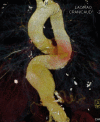Successful reversal of recurrent spinal cord ischemia following endovascular repair of a descending thoracic aortic aneurysm
- PMID: 23439968
- PMCID: PMC3485390
Successful reversal of recurrent spinal cord ischemia following endovascular repair of a descending thoracic aortic aneurysm
Abstract
Despite recent advances in technique, spinal cord ischemia remains one of the most dreaded complications of thoracic aortic surgery. Recently, it has been suggested that thoracic endovascular aortic repair may decrease the risk of paraplegia. We present a case of delayed paraplegia following thoracic endovascular aortic repair that was successfully reversed on 3 separate occasions in the same patient. This highlights the importance of vigilant clinical assessments, efficient multidisciplinary teamwork, and maintenance of the determinants of spinal cord perfusion following endovascular thoracic aortic intervention.
Keywords: anesthesia; aneurysm; endovascular aortic repair; spinal cord ischemia; spinal cord paraplegia; vascular surgery.
Conflict of interest statement
Figures


Similar articles
-
Strategies to manage paraplegia risk after endovascular stent repair of descending thoracic aortic aneurysms.Ann Thorac Surg. 2005 Oct;80(4):1280-8; discussion 1288-9. doi: 10.1016/j.athoracsur.2005.04.027. Ann Thorac Surg. 2005. PMID: 16181855 Clinical Trial.
-
Risk of spinal cord ischemia after endograft repair of thoracic aortic aneurysms.J Vasc Surg. 2001 Dec;34(6):997-1003. doi: 10.1067/mva.2001.119890. J Vasc Surg. 2001. PMID: 11743551
-
Endovascular thoracic aortic repair and previous or concomitant abdominal aortic repair: is the increased risk of spinal cord ischemia real?Ann Vasc Surg. 2006 Mar;20(2):188-94. doi: 10.1007/s10016-006-9010-6. Epub 2006 Mar 21. Ann Vasc Surg. 2006. PMID: 16550478
-
Spinal cord protection and thoracic aortic surgery.Curr Opin Anaesthesiol. 2010 Feb;23(1):95-102. doi: 10.1097/ACO.0b013e3283348975. Curr Opin Anaesthesiol. 2010. PMID: 19920758 Review.
-
Cerebrospinal fluid drainage and thoracic endovascular aneurysm repair.Asian Cardiovasc Thorac Ann. 2017 Nov;25(9):608-617. doi: 10.1177/0218492317739472. Epub 2017 Oct 23. Asian Cardiovasc Thorac Ann. 2017. PMID: 29058970 Review.
Cited by
-
Endovascular repair of thoracic and abdominal aortic ruptures: a single-center experience.Diagn Interv Radiol. 2014 May-Jun;20(3):259-66. doi: 10.5152/dir.2013.13165. Diagn Interv Radiol. 2014. PMID: 24412816 Free PMC article.
References
-
- Setacci F, Sirignano P, De Donato G. et al. Endovascular thoracic aortic repair and risk of spinal cord ischemia: the role of previous or concomitant treatment for aortic aneurysm. J Cardiovasc Surg 2010; 51: 169-76. 2010;51:169–176. - PubMed
-
- Bavaria J E, Appoo J J, Makaroun M S. et al. Endovascular stent grafting versus open surgical repair of descending thoracic aortic aneurysms in low-risk patients: a multicenter comparative trial. J Thorac Cardiovasc Surg. 2007;133:369–377. - PubMed
-
- Estrera A L, Miller CC 3rd C C, Huynh T T. et al. Preoperative and operative predictors of delayed neurologic deficit following repair of thoracoabdominal aortic aneurysm. J Thorac Cardiovasc Surg. 2003;126:1288–1294. - PubMed
-
- Cheung A T, Pochettino A, McGarvey M L. et al. Strategies to manage paraplegia risk after endovascular stent repair of descending thoracic aortic aneurysms. Ann Thorac Surgery. 2005;80:1280–1288. - PubMed
-
- Buth J, Harris P L, Hobo R. et al. Neurologic complications associated with endovascular repair of thoracic aortic pathology: incidence and risk factors. A study from the European Collaborators on Stent/Graft Techniques for Aortic Aneurysm Repair (EUROSTAR) Registry. J Vasc Surgery. 2007;46:1103–1111. - PubMed
Publication types
LinkOut - more resources
Full Text Sources
